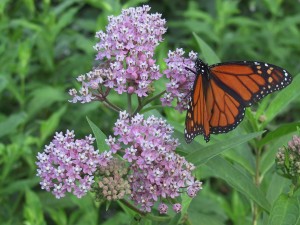 The brilliant orange contrasted by jet black accents are the unmistakable flashes of color showcased by the monarch butterfly. Grace and elegance are words that come to mind when thinking of this wonderful species floating about in a garden. But there is more to the story than simply the sheer beauty of this fascinating creature.
The brilliant orange contrasted by jet black accents are the unmistakable flashes of color showcased by the monarch butterfly. Grace and elegance are words that come to mind when thinking of this wonderful species floating about in a garden. But there is more to the story than simply the sheer beauty of this fascinating creature.
Every year this delicate, little butterfly undergoes a miraculous journey, where it migrates, primarily, from central Mexico to all across North America. It takes the average monarch about two months to complete the trek to its breeding grounds. Weighing in at less than a gram it will travel nearly 5,000 kilometers to reach its furthermost destinations in Canada. A truly amazing feat of nature that sometimes goes overlooked based upon its remarkable beauty.
How To Help
After making a journey northward the monarch is in search of one thing: Milkweed. This is the only plant that monarch caterpillars can feed upon. Without milkweed in the area the long trip up north could be futile.
The female Monarch will lay eggs on the underside of the milkweed plant’s leaves. Once the eggs hatch, the young caterpillars will eat away at the leaves of the milkweed for (1-2) weeks. Which will then lead to the metamorphosis stage where the plump caterpillar will make a chrysalis and emerge the gorgeous orange-and-black winged adult butterfly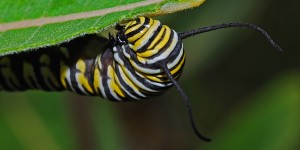 .
.
But in order for this process to be completed there must be milkweed host plants. The monarch is known as a specialist species. This means that it will only target milkweed plants for its offspring. An abundance of milkweed is vitally important for efforts to increase and sustain a healthy population of this magnificent butterfly.
What types of milkweed?
There are 14 types of milkweed in Canada that can play host to monarch butterfly. Let’s look at four of the best choices for a native milkweed species to attract monarch butterflies.
Common Milkweed – Asclepias syriaca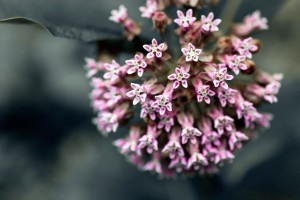
Willing to survive in poor, dry soil this is a tough plant. Fragrant flowers grow on domed umbels with a slightly pinkish-purple complexion. Flowers eventually give way to seed pods that eventually split open letting loose silky tailed seeds that are spread by wind.
A warning to gardeners is that it will spread (when in ideal conditions) and needs to be maintained. It is ideal for naturalized areas (meadows, ditches, prairies and large garden)
Height: 2-3 feet
Spread: 1 foot
Sun: Full Sun
Moisture: Dry to medium
Bloom: June to August
Butterflyweed – Asclepias tuberosa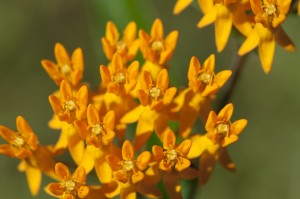
This milkweed variety has brilliant orange-domed umbels that are perfect landing pads for equally colorful monarchs. It is drought tolerant and can survive in wide variety of soils.
Height: 1-2.5’
Spread: 1-1.5’
Sun: Full Sun
Water: Dry to medium
Bloom: June to August
Swamp Milkweed – Asclepias incarnata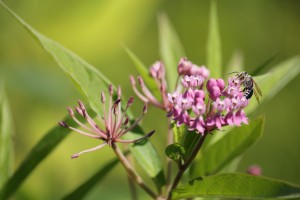
This milkweed species is known for its ability to thrive in swampy areas and wet meadows. Despite its love of wet soils, due to its long taproot, it can tolerate average well-drained soils with ease. Pink and white duo-tone flowers are displayed throughout the summer months.
Height: 4-5 feet
Spread: 2-3 feet
Sun: Full
Water: Medium to wet
Bloom: July-August
Another great choice is whorled milkweed (Asclepias verticillata) as its white flowers and skinny leaves provide an aesthetic difference to standard milkweed appearance.
Milkweed is versatile
Not only do milkweed plants act as a host for the monarch butterfly but they provide nectar for other pollinators. Don’t be surprised to find it a favorite destination for other butterflies, hummingbirds and bees. This resilient family (Asclepias) of flowers is like a Swiss army knife for a gardener aiming to support local pollinators.
Why is it so important?
Monarchs have been listed under the special concern classification for species in Canada. The population numbers have been declining. Some numbers indicate that the population is down 80% from 20 years ago in Canada. This in part due to a lack of available milkweed, the use of herbicides and pesticides and the deforestation of their winter habitat in Mexico.
 Recommendations for Ontario gardeners aiming to help monarchs
Recommendations for Ontario gardeners aiming to help monarchs
- Pesticide free approach to weed control
- Incorporating milkweed species in gardens and landscapes where possible
- Avoiding the trimming of naturalized areas (ditches, swales, etc.) where milkweed is naturally growing
Let’s get planting
Add some milkweed to your garden palette or naturalized area to support this magnificent species. There is nothing more satisfying than knowing your garden is not only beautiful but functional for species desperately in need of a helping hand like the monarch butterfly.
After you have added milkweed to your garden design, don’t be surprised if you find the leaves of your milkweed to virtually disappear overnight. But relax, because a natural process is taking place that has for generations before. Chances are a monarch caterpillar is “packing on the pounds” so it can transform into a magnificent butterfly itself. Milkweed is tough and will bounce back. Nature at its best. Take a moment to observe and enjoy the show.
And don’t forget to pat yourself on the back for saving the planet one native plant at a time.
Notes
How to tell the difference between a monarch and viceroy butterfly click here